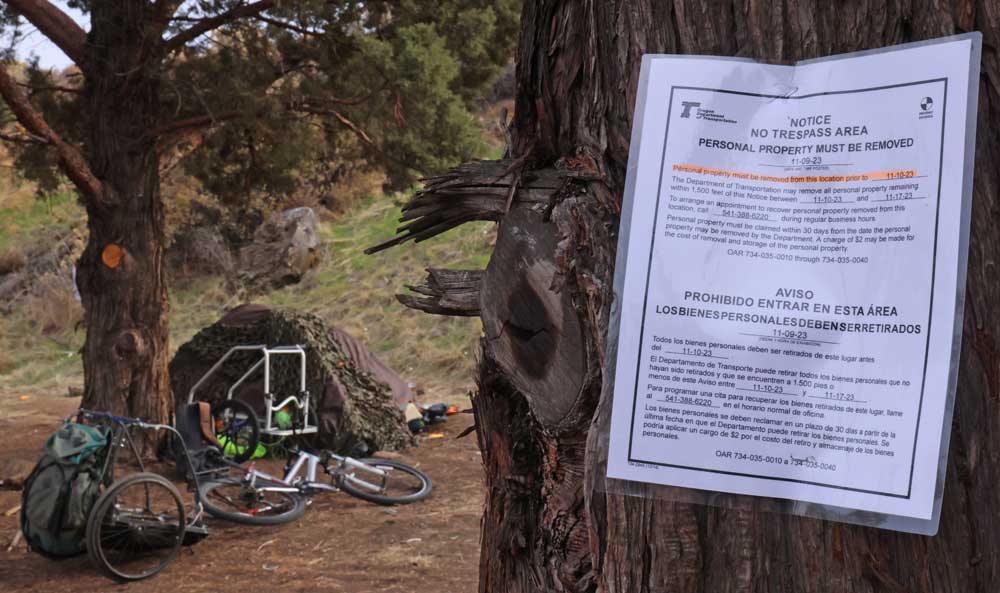New data shows spike in homelessness spending amid ODOT service cut-backs
Published 5:45 am Tuesday, November 14, 2023

- Notices posted near camps at Reed Market Road and U.S. Highway 97 in Bend warn homeless individuals of a coming sweep.
As lawmakers and residents scrutinize the Oregon Department of Transportation for its recent decision to cut back on snowplowing and other road maintenance services across the state, homeless encampment removals are not slowing down for now.
While the department’s cutbacks likely mean more trash, potholes and ruts in the road, addressing homeless encampments will also see delays.
“ODOT has slowly been going broke for the last four years,” Travis Brouwer, the department’s assistant director of finance, told the Legislature’s joint committee on transportation on Wednesday.
The department has cited revenue issues, which have been attributed to dwindling fuel tax revenues, as reasoning for rolling back services. Plus, the cost of doing business, from as large as replacing a snowplow to as small as buying paint, has risen, department officials say.
Central Oregon roads will look different this winter after ODOT reduces services
Belt-tightening simply isn’t cutting it anymore, Brouwer said during the meeting. Most services, except those in Driver and Motor Vehicle Services, will be cut back, he said.
Despite this, the department is preparing to clear several more homeless encampments near U.S. Highway 97 in Bend in the coming days and weeks, including those that have again set up along a walking and bike path near a local brewpub. It’s at least the fourth time campers have been asked to leave from that same location this year.
City clears homeless camps near Crux; more sweeps incoming
People have increasingly chosen to temporarily live on state transportation department property this year as it is one of the only places they can stay within cities for longer than a few days.
The department has spent more than $1 million so far this year on litter cleanup, graffiti removal, abandoned vehicles and homeless encampments in the Central Oregon region, or Region 4, which stretches from the Columbia River to the California border, according to data provided by department spokesperson for Region 4, Kacey Davey.
The region includes all of Crook, Deschutes and Jefferson counties, among several others.
Over the years, clearing homeless encampments, cleaning up graffiti and picking up litter have been a growing focus of the department’s time and money.
ODOT tries something new to address homelessness as cleanups continue
In Central Oregon, as of Oct. 31, the department’s spending on homeless encampments had already surpassed that of 2022. The department has spent more than $368,000 on homeless encampments so far this year compared to last year’s roughly $247,000 total.
However, spending on litter pickup in Region 4 is almost double that of homeless encampments. This year, the department has spent more than $674,000 on litter.
“Over the past 5 years, we’ve seen a 38% increase in expenses related to campsite, graffiti, litter and abandoned property cleanup in Region 4,” Davey wrote in an email.
The service cutbacks mean Region 4 residents will likely “see more graffiti and debris, particularly in the urban areas of the region, along with more vegetation growth in medians and along highways,” a factsheet detailing the cutbacks reads.
Statewide, the department spent about $8.6 million per year clearing homeless encampments and cleaning up graffiti and litter between 2018 and 2022, according to Davey.
Last year, across the state, the department spent roughly $4.6 million on homeless encampments alone.
As homeless encampments have become more common across the state’s highway system, they’ve simultaneously been a growing challenge for transportation departments across the country. Researchers at Portland State University have begun to craft a guide for departments to use to address encampments. Accepted guidelines don’t currently exist.
Temporarily living along highways is widely regarded as a major safety hazard, and departments of transportation are largely unequipped to deal with the social service aspects associated with homelessness. Thus, the project, which is funded with $350,000 from the National Cooperative Highway Research Program, is aiming to create best practices for responding to, managing and deterring people from living along transportation rights of way.
The project is scheduled to be completed by the end of 2024.
Homeless camp sweeps: What happens when homeless people are made to move?








